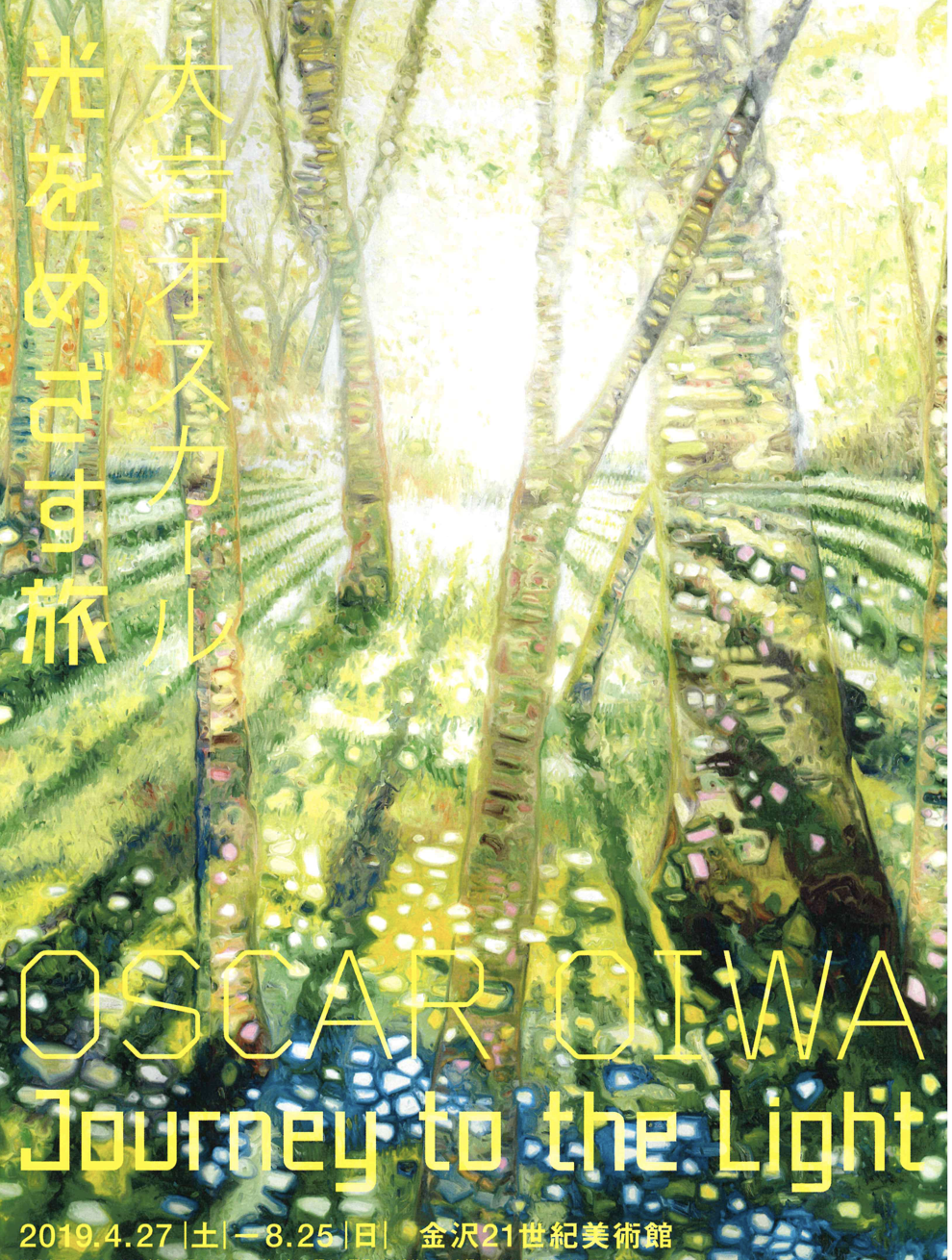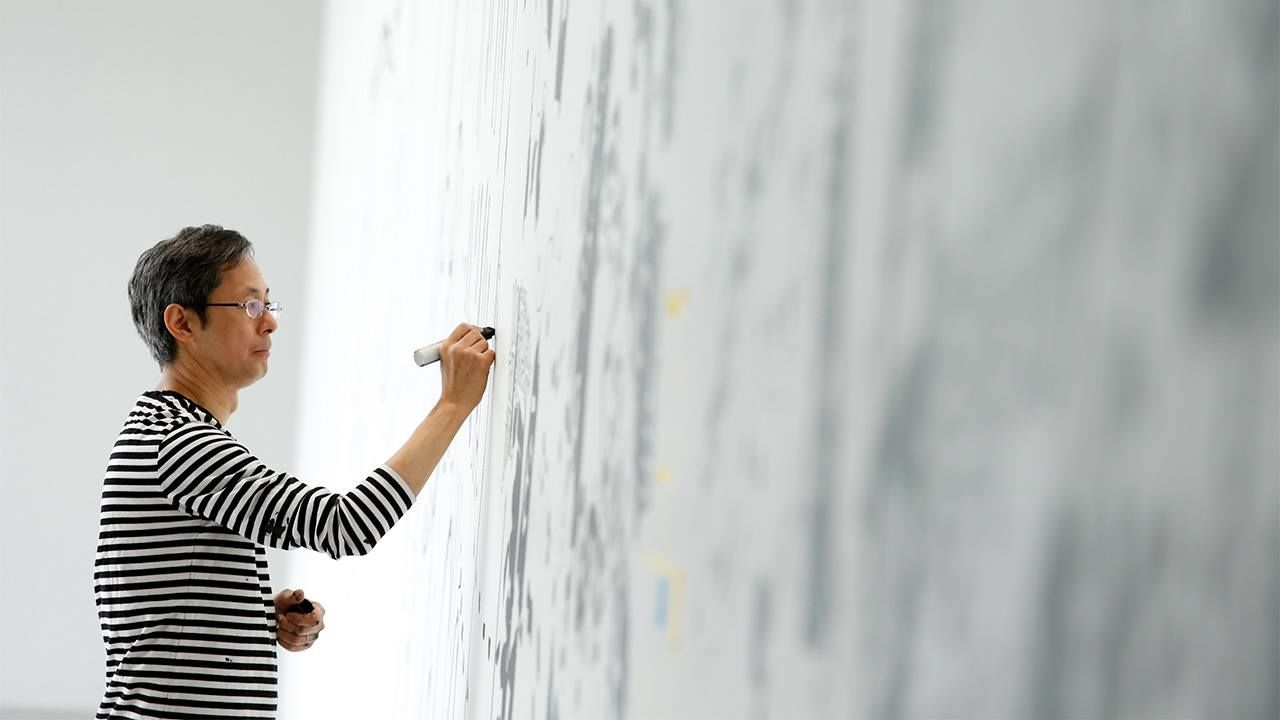
Painter Oscar Oiwa Charts His Path to the Light
Art Culture- English
- 日本語
- 简体字
- 繁體字
- Français
- Español
- العربية
- Русский
There’s something spellbinding about Oscar Oiwa’s artworks—they’re like gateways to other worlds. The colorful, detailed canvases are as engrossing as they are enormous: some over 2 meters tall and 6 meters across, they depict flooded cityscapes, ocean vortices, and forest vistas glittering with mysterious will-o’-the-wisp lights. A new exhibition at the 21st Century Museum of Contemporary Art, Kanazawa, Journey to the Light reflects the evolution of this multifaceted Brazilian-Japanese artist who is at turns phantasmagorical, political, and comedic.
Solo exhibition, Oscar Oiwa: Journey to the Light
21st Century Museum of Contemporary Art, Kanazawa, Ishikawa
April 27–August 25, 2019 Wall drawing Woods, 2019. Marker pen and acrylic ink on wall, 27 x 4 meters.
Oscar Oiwa is known for creating some of the world’s largest drawings. His Paradise is an immersive installation of swirling clouds executed with marker pen on a balloon-like vinyl sheet that’s the size of a house (view the video on YouTube showing Oiwa meticulously creating the scene). Journey to the Light, which groups about 60 of Oiwa’s recent works at the 21st Century Museum of Contemporary Art, Kanazawa, features another overwhelming drawing: the 4 meter by 27 meter Woods, which takes up an entire wall. Oiwa and eight assistants worked for nearly 90 hours to complete Woods, an almost obsessively detailed mural that pairs a cartoonlike cat and rabbit in a forest of radiant light.
“This is my biggest work on a single surface,” says Oiwa. “Many people use digital media now, but humans going back to the time of cavemen have always made drawings. Our kids still draw, but adults have forgotten how to make drawings. I want to recover this very simple way to make art using a marker on a wall or balloon.”
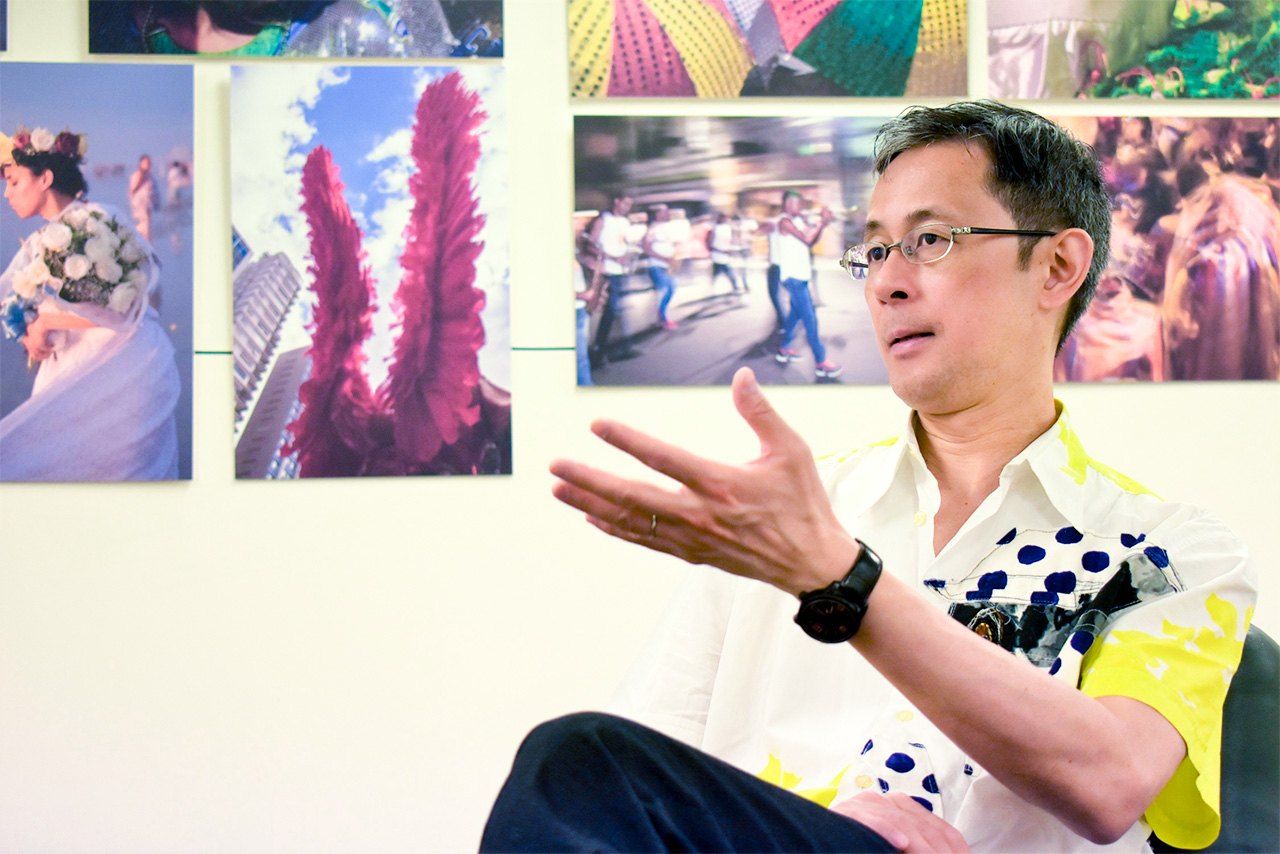
Oiwa speaks about his art in an interview at the Brazilian embassy in Tokyo.
A Richly Mixed Palette
Oiwa’s unique background has deeply informed his oeuvre. His parents both hail from Japan, but they met in Brazil in the early 1950s, part of the twentieth-century wave of Japanese immigration to the South American country. Oiwa was born in São Paulo in 1965 and spoke Japanese at home, but he had limited experiences with Japanese culture until he visited Japan for the first time at age 20. He loved drawing from an early age and experimented with oil painting in high school, later learning acrylics and watercolors in addition to metalworking and jewelry making. His father enjoyed collecting art books, instilling in young Oscar a love for Japanese and Dutch masters and such artists as the English landscape painter John Constable.
While studying at the University of São Paulo, Oiwa attended the Art Biennial in that city, where he came into contact with contemporary artists like Keith Haring. He credits the pop art icon with inspiring him to eventually become an artist. After graduating in 1989, Oiwa worked as an architect while pursuing his art, living in Tokyo, London, and New York, where he settled at age 37.
“My first country is Brazil and then Japan,” says Oiwa. “I live in New York, where I feel comfortable, but I don’t really feel like a part of US culture as I didn’t grow up there. I grew up in Brazil with a Japanese influence and always felt comfortable with Latin American and European cultures.”
As Oiwa grew in prominence as an artist, he held his first solo exhibition in the 1990s and received grants and fellowships from the Asian Cultural Council and the John Simon Guggenheim Memorial Foundation. His major shows have included exhibitions at the Ueno Royal Museum in Tokyo, the Museu Nacional de Belas Artes in Rio de Janeiro, and Japan’s Setouchi Triennale, which he rejoins this year.
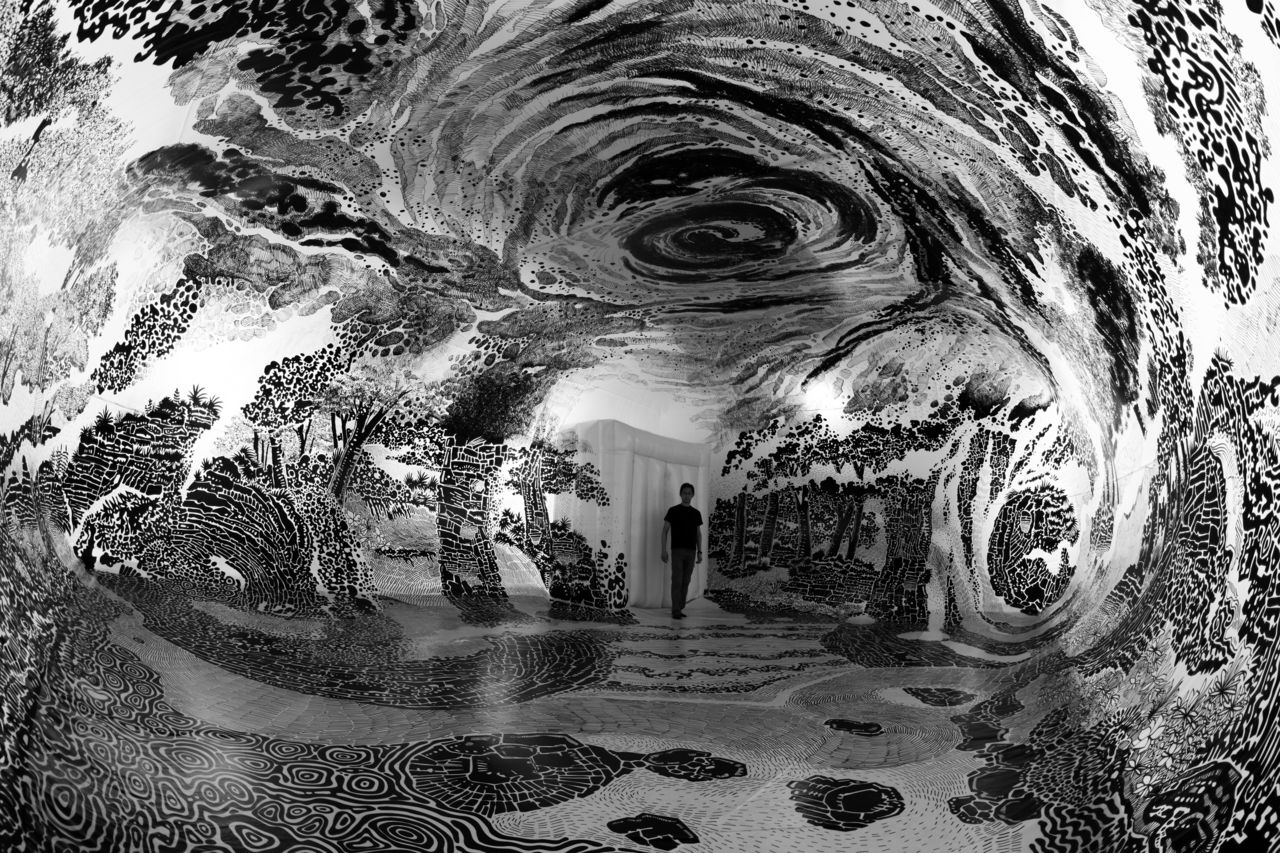
Paradise 2018. Marker pen on vinyl sheet, 10 x 7 x 4 meters. Japan House, São Paulo. The work was destroyed after the exhibition.
Cities of the Past and Future
Oiwa’s works at the Kanazawa museum are divided into six chapters: Waves in New York City, (Dis)United States of America, Life as an Eternal Journey, A Very Imperfect World, Aiming for Light, and After All, We Remain Hopeful. In addition to paintings, the exhibition includes drawings and sculptures.
“It took ten years to prepare the paintings for this exhibition, so viewers should take as much time as they can to absorb them,” says Oiwa. “I hope people can visit when the museum is not too crowded so they can see the details of the works.”
People are almost entirely absent in Oiwa’s works, imparting a sense of alienation amid a general malaise over globalization and US politics and society in particular. In an introduction to (Dis)United States of America, Oiwa writes of the election of President Barack Obama, “The keyword in that era was ‘hope.’ It seemed like things were getting a bit better, but eight years later Trump became president. Congress is sharply divided and it looks like a circus. The White House is in chaos and everything seems like a lie. My only hope is that a war doesn’t break out.”
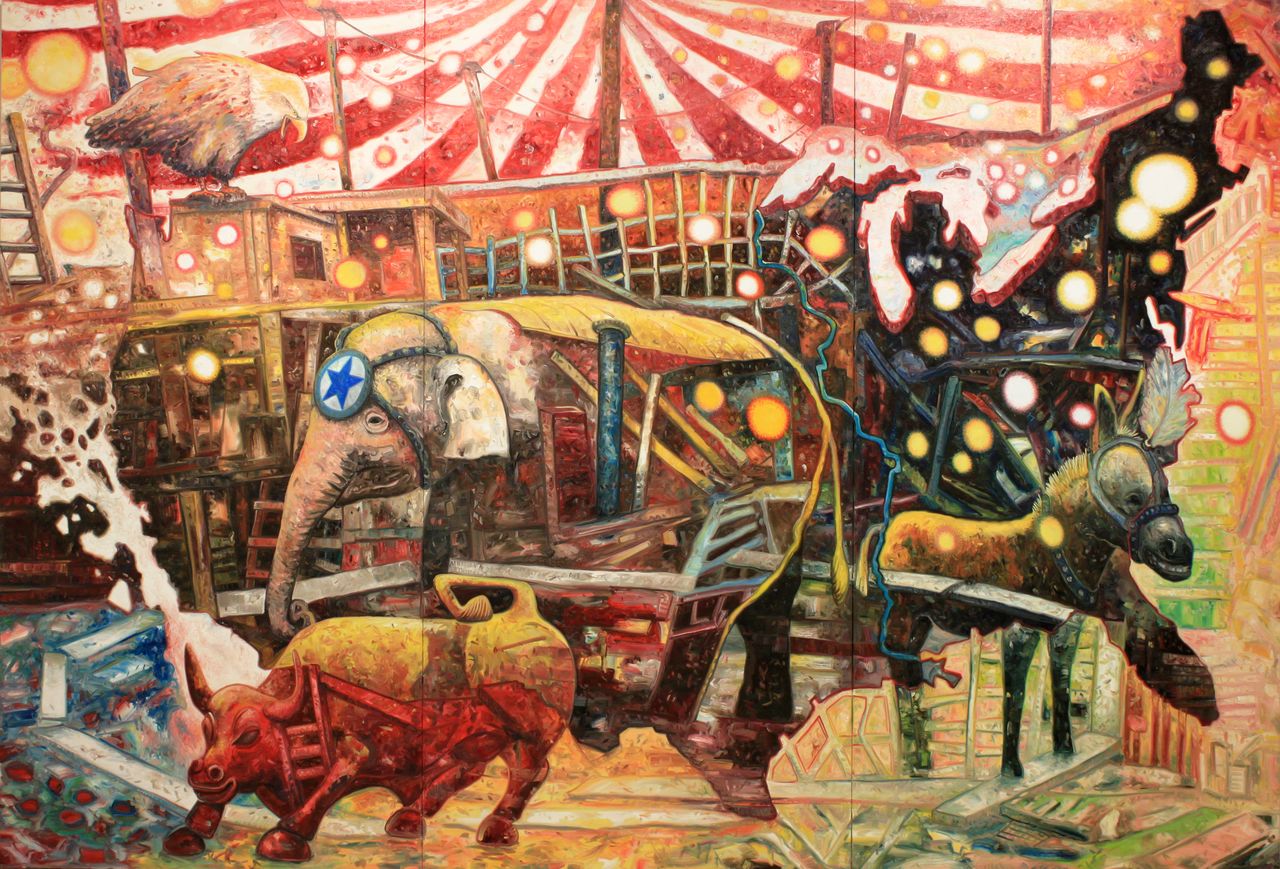
Big Circus, 2011. Oil on canvas, 227 x 333 cm. Collection of the artist. (©Oscar Oiwa Studio )
Other works brood over urban decay or disaster. City from the Past and City from the Future, both created in 2008, feature the transformation of a Chinese city block from a crumbling slum decorated with Mao Zedong’s picture into a gentrified neighborhood complete with art galleries, Starbucks, McDonald’s, and a FedEx truck; only the Mao picture remains unchanged.
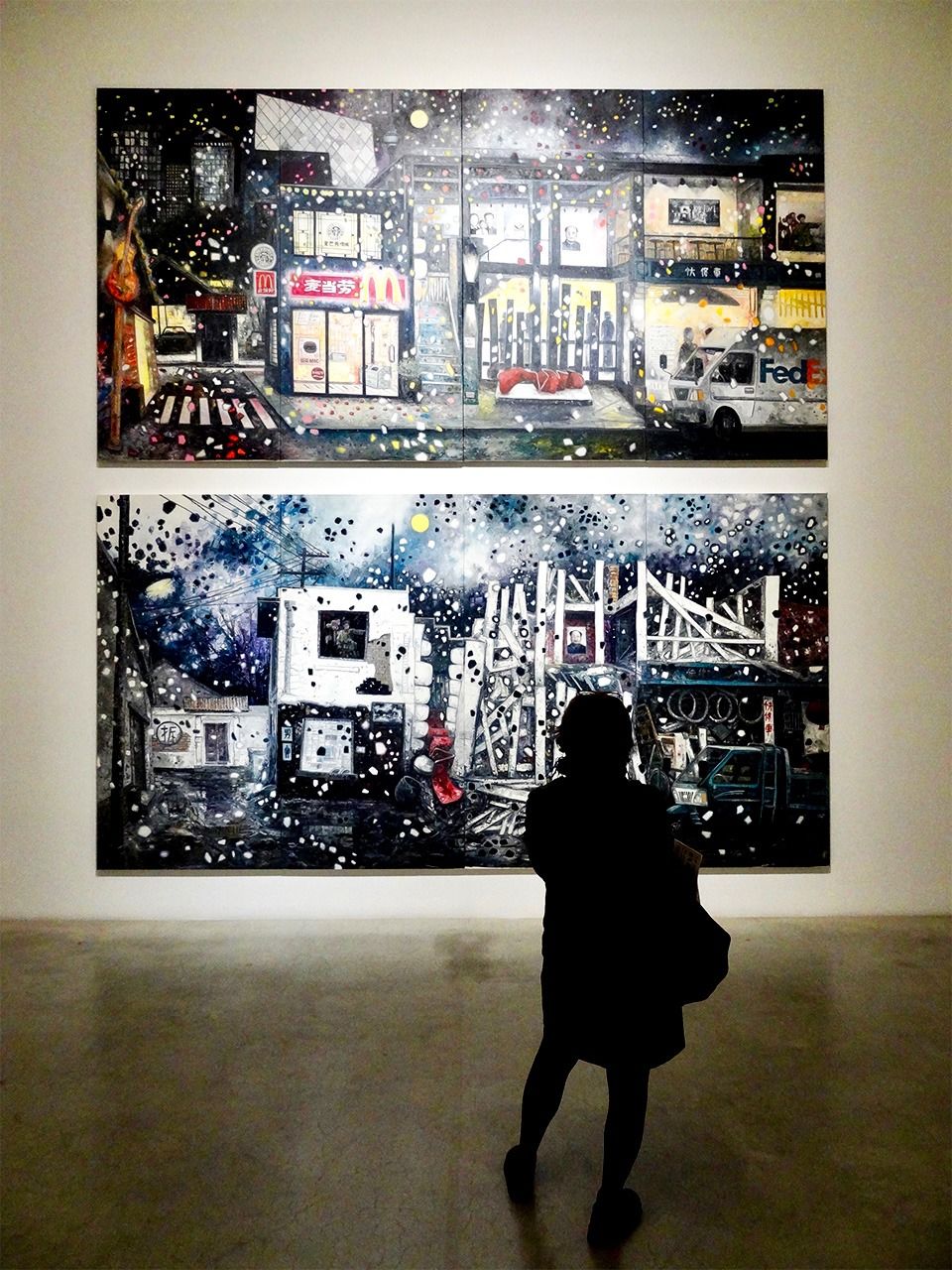
City from the Past and City from the Future, 2008. On display at the 21st Century Museum of Contemporary Art, Kanazawa. (© Tim Hornyak)
A tanker has toppled over on cliff road in 2013’s The Accident, spewing pollutants that merge into a rainbow-colored valley below. In 2011’s Swirl, a flurry of luminescent rectangles falls from a circular opening (the bottom of a UFO?) into an ominous ocean maelstrom below. Nearby, a swell of orchestral strings seems to echo the dizzying vortex. Speakers are pumping out The Dreams of a Sleeping World, a sound track inspired by Oiwa’s work and created by the American composer Chad Cannon, whose work has been featured in films such as The Hobbit, The Secret Life of Pets, and American Factory.
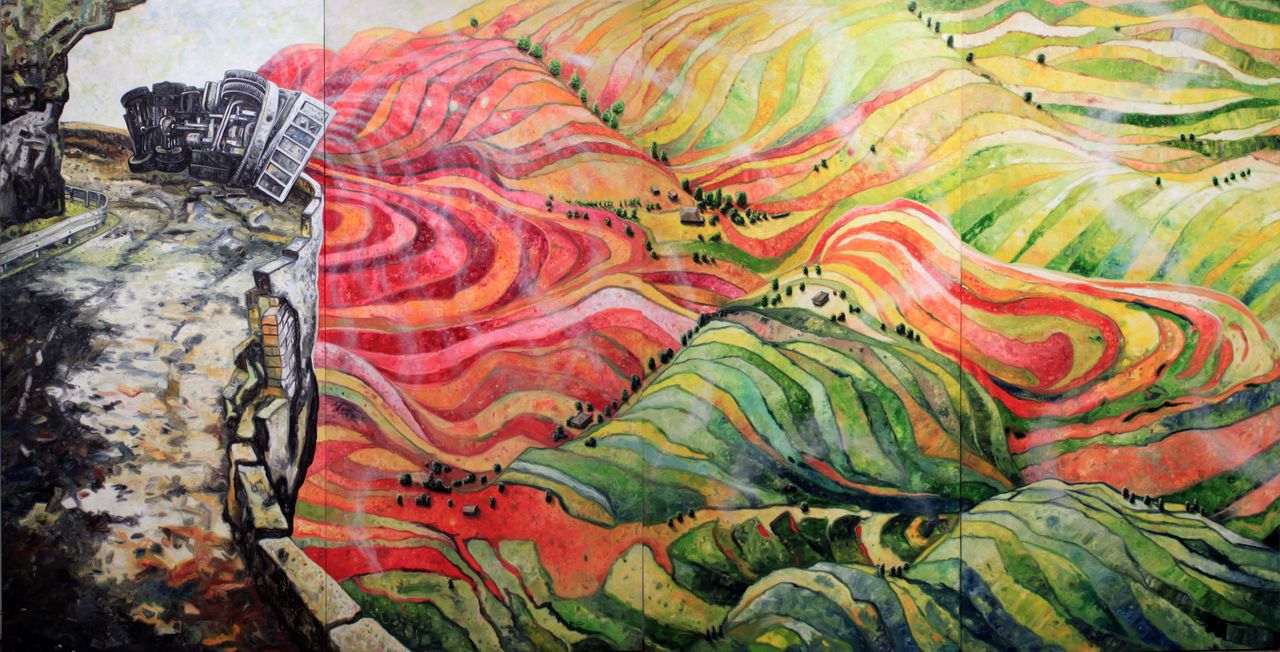
Accident, 2013. Oil on canvas, 227 x 444 cm. Collection of the artist.(©Oscar Oiwa Studio )
“I like to collaborate with musicians, photographers, videographers and other artists,” says Oiwa. “To create music from artworks is very complicated, as you need to write parts for fifteen or twenty instruments. It’s very interesting to work with musicians because art is visual and they work with sound—they’re completely different, but we can join together. It’s like movies being a combination of imagery and the soundtrack.”
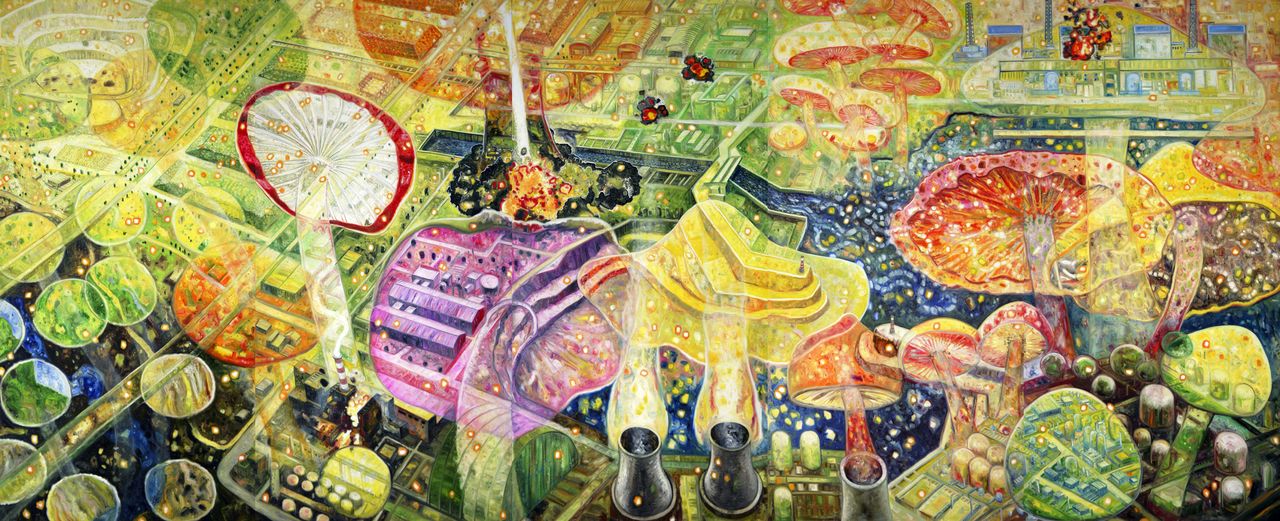
Mushroom Forest, 2016. Oil on canvas, 227 x 555 cm. Collection of the artist.(©Oscar Oiwa Studio )
From Darkness Into Light
Oiwa is no stranger to darker themes leavened with optimism or irony. His 2004 oil on canvas Flower Garden, in the collection of the Hiroshima City Museum of Contemporary Art, consists of five panels centering on a large tree that grows out of the shadowy buildings of a Hiroshima yet to be destroyed; the cityscape is overlaid with myriad phosphorescent flowers. The 2016 Mushroom Forest, included in the Kanazawa exhibition, commemorates another Japanese cataclysm, the 2011 Fukushima nuclear power plant meltdowns, with giant, semitransparent toadstools sprouting from a green glowing landscape with nuclear cooling towers.
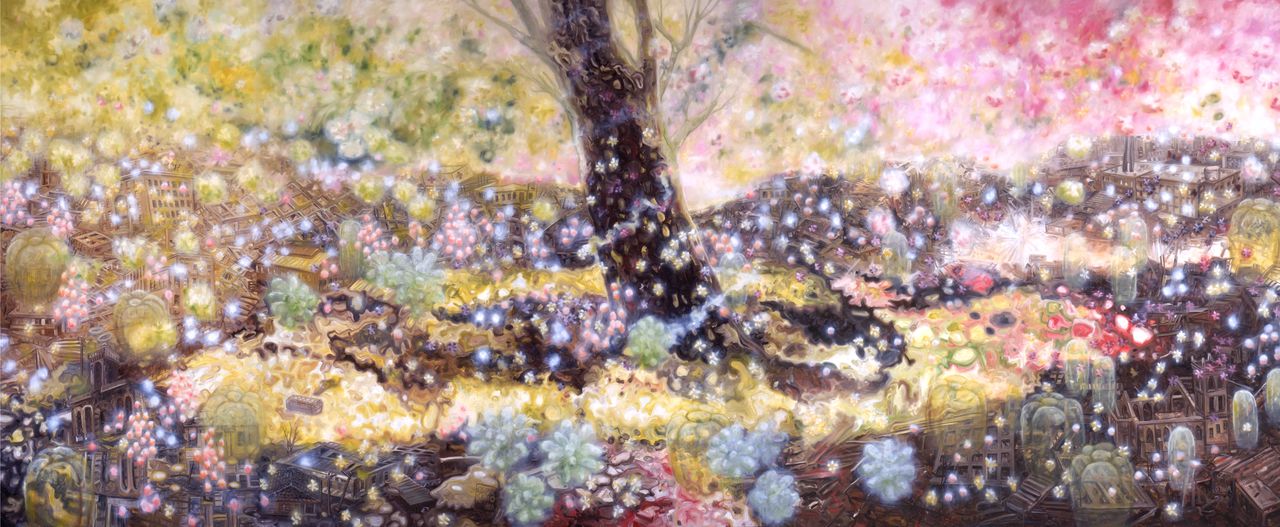
Flower Garden, 2004. 227 x 444 cm, Hiroshima City Museum of Contemporary Art collection.
Journey to the Light is ultimately hopeful, even uplifting, and always playful. The exhibition’s last chapters present the ever-present theme of light in different ways. A specially darkened room showcases works that are intended to excite the human eye’s rod cells, photoreceptors that are designed to detect shapes in semidarkness. It showcases paintings with subdued palettes and elements such as composition gold and silver leaf and LED lights: Vortex (2018) is a whirlpool of glowing dots over a ring of urban architecture. In the final room, the exhibition’s titular work is a yellow-green canvas depicting transparent trees in a glade exploding with sunlight.
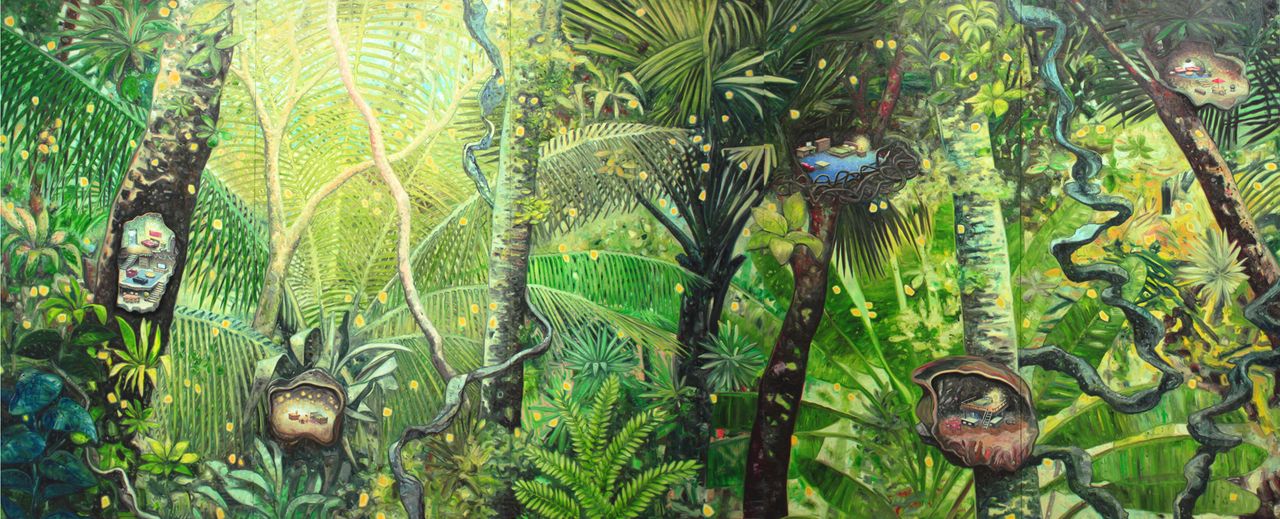
Five Nests, 2012. Oil on canvas, 227 x 555 cm. Collection of the artist. (©Oscar Oiwa Studio )
“Recently, I decided that in order to become happy, it’s important to cultivate the light I’m aiming for myself,” Oiwa writes in an introduction to the last part of the exhibition. “It seems to me that happiness isn’t something that you get, it’s something you make. Thinking that I’d like to give form to this abstract idea, I made a series of works with greens and blues that are overflowing with light.”
Journey to the Light continues until August 25, 2019, at the 21st Century Museum of Contemporary Art, Kanazawa.
(Originally written in English. Banner photo: Oiwa prepares Woods for display at the Kanazawa exhibition. ©Keizo Kioku, Courtesy of the 21st Century Museum of Contemporary Art, Kanazawa)
Kanazawa art Oscar Oiwa Japanese Brazilian Japanese Brazilian Kanazawa Japanese Brazilian Kanazawa
